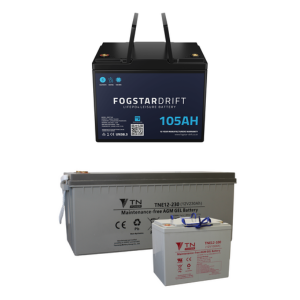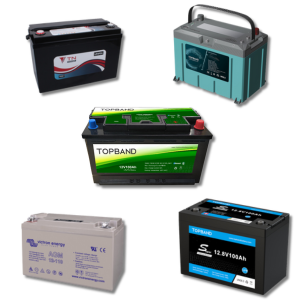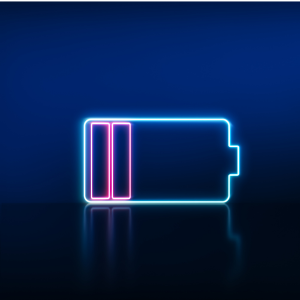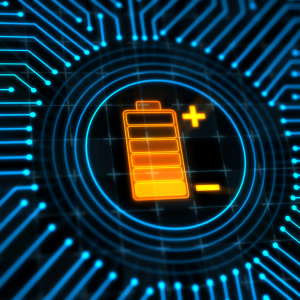How Long Will A 12v Battery Last?
12V deep cycle batteries are commonly found in various applications, from powering habitation electrical systems in vehicles and boats, to supporting renewable energy systems and running household appliances in off-grid setups. One of the most common concerns among users is understanding how long these batteries will last, both in terms of running time remaining until needing to recharge, and the longer term useable lifespan.
This is actually quite difficult to quantify because both of these can vary enormously and are heavily influenced by several factors including the design and type of battery chemistry, usage patterns (how it is discharged), environmental conditions, and charging & maintenance practices. This article explores these factors, offers recommendations on how to maximise lifespan, and shows you how to estimate the running time before you need to recharge.
Types of 12V Battery
First, let's look at the various types of 12V battery used in deep cycle applications. Below we've listed the most common ones used in automotive, recreational, marine, and off-grid installations, together with a brief description and a run down of their key characteristics.
- Flooded - These have traditionally been the most common type of deep cycle battery based on the long established lead-acid technology, with lead plates immersed in a sulphuric acid electrolyte. The oxygen and hydrogen produced during charging can escape, eventually leading to the water in the electrolyte drying up if not topped up periodically. If the electrolyte dries up, the battery will be damaged and performance will reduce.
- Liquid electrolyte - requires maintenance
- Designed for moderate continuous current draw
- Typical cycle life - 150-200 at 80% DoD* (average life expectancy 3-5 years)
- Prone to sulfation if left in a partially charged state
- Requires a maintenance charge every few months if un-used
- Charge rate 0.1 - 0.2C**
- Wide charge/discharge temperature range
- Must be fitted upright
- Absorbent Glass Mat (AGM) - these are sealed batteries based on lead-acid technology but the electrolyte is encapsulated in a fine fibreglass matting that makes them spill proof and lighter than flooded batteries, with better life cycle and higher discharge rates. They are part of the Valve Regulated Lead Acid (VRLA) family of lead acid batteries that recombine the hydrogen and oxygen produced during charging back into water under moderate pressure, and have a safety release valve built in to allow excess gas to escape.
- Electrolyte absorbed into glass mats - maintenance free
- Can deliver high currents
- Typical cycle life - 300-500 at max. 80% DoD (average life expectancy 5-7 years)
- Less prone to sulfation than flooded
- Requires a maintenance charge every few months if unused
- Charge rate 0.2C+
- Sensitive to over-charging
- Good performance at low temperature
- Can be fitted on their side (spill proof)
- Gel - these are also sealed VRLA batteries but the electrolyte is suspended in a silica type gel, also making them spill proof. They perform well at high temperatures and the performance level stays constant until near end of life, but they are not good at delivering high currents (unlike AGM batteries).
- Electrolyte suspended in a silica gel - maintenance free
- Designed to deliver low to moderate currents
- Typical cycle life - 500-1000 at max. 80% DoD (average life expectancy 7-10 years)
- Less prone to sulfation than flooded
- Requires a maintenance charge every few months if unused
- Charge rate 01. - 0.2C
- Sensitive to over-charging
- Good performance at high temperature
- Can be fitted on their side (spill proof)
- Lithium Iron Phosphate (LiFePO4) - a relatively new technology and a type of lithium-ion battery that is now very popular as a choice for deep cycle battery applications due to their efficiency, light weight, high charge/discharge rates, long lifespan, and low maintenance. For safety they require over charge/discharge and over/under temperature protection, but the vast majority of off-the-shelf batteries come with a battery management system (BMS) built-in to take care of this. They can't be charged at temperatures below 0°C, although many have built in heaters that raise the battery temperature to allow charging. Many also now feature a BMS with Bluetooth communication so you can monitor the battery's performance via a phone App.
- Can deliver high currents
- Typical cycle life - 2000-5000 at max. 80% DoD (average life expectancy 10-15 years)
- Can be discharged very deeply (more usable Ah capacity)
- Extremely low self discharge - virtually zero maintenance
- Charge rate typically 0.5C+
- Can be discharged but not charged below 0°C
- Half the weight of an equivalent flooded lead acid battery
- Needs BMS protection for safety
- Often come with Bluetooth communication for use with an App
* Battery life will vary significantly with the pattern of usage, so manufacturers typically quote the number of expected charge/discharge cycles based on an 80% depth of discharge (DoD) at a given charge and discharge rate. This means that the battery can be discharged by 80% of its capacity (20% remaining) and fully recharged the number of quoted times before the battery reaches the end of its life.
** Recommended charge and discharge rates are quoted by manufacturers as a proportion of the battery's capacity in Ah. So a 0.2C charge/discharge rate for a 100Ah battery would be 20A, and this figure is normally quoted alongside the DoD when stating the cycle life (e.g. 500 cycles at 80% DoD, 0.2C). This is important to bear in mind when selecting a charger for your battery or when considering connecting a large load like a high output inverter, because exceeding the maximum recommend charge/discharge rates could reduce the lifespan, particularly with lead acid batteries.
Factors Affecting Battery Life
It's important to distinguish between the time a battery can be used before it is discharged and needs to be recharged (sometimes referred to as 'time-to-go'), and the overall lifetime of a battery that's reached once the reversible chemical reaction inside is no longer possible. These two things are both important, but in terms of day-to-day use the time-to-go between recharges will be of far more interest and relevance.
Overall lifetime
In terms of overall lifetime of a battery, there are several key factors that will determine this. We've listed these below, along with recommendations on how to maximise this lifetime.
Usage patterns
DoD is one of the most significant factors affecting battery life and regularly discharging a battery to low levels can rapidly shorten its lifespan. Lead acid batteries should ideally not be discharged beyond 50% of their capacity, and shallower discharges can result in a significant increase in lifespan. Lithium batteries can handle much deeper discharges but will still benefit from shallower cycles.
Discharge current also has a significant bearing on battery life. Larger discharge currents will shorten battery life, whilst smaller discharge currents will extend battery life. Applications demanding higher current draws for longer periods (e.g. inverters running for several hours) might be unavoidable if the application demands it, and this is fine as long as you are aware that you will need to change your batteries more regularly. So in summary, if you can, try to run your battery with shallower discharges at lower currents to extend battery life.
Charging & discharging practices
Overcharging or undercharging can damage batteries so using a suitable charger and following recommended charging practices helps prolong battery life. Smart chargers that adjust to the battery’s needs can be particularly beneficial. Ensure the charger is multi-stage, of the correct current rating for your battery type and capacity, and can be programmed with the correct charging voltages for your specific battery type/chemistry. If in doubt, consult the manufacturer's datasheet or user manual for recommended charge rates and charging voltages. High end chargers like the Blue Smart range from Victron Energy have adaptive charging processes that will monitor the pattern of usage of the battery and adjust the charging stages accordingly to optimise battery life. For more information on selecting a charger, click here.
Also important is how you connect your charging sources to your batteries. Cables should be large enough to prevent excessive voltage drop and positive and negative cables the same length. Where batteries are connected in parallel, charging sources should be connected across the bank to ensure all batteries receive equal charge voltages. By this, we mean that the positive charging cable should connect to the positive terminal of the first battery, and the negative charging cable should connect to the negative terminal of the last battery. This 'across-the-bank' connection pattern applies equally to loads as it does to charging sources, ensuring all batteries are discharged at the same rate.
Environmental conditions
Extreme temperatures can negatively impact battery life. High temperatures accelerate chemical reactions inside the battery, leading to faster degradation, whilst cold temperatures can reduce a battery's effective capacity, making it harder to charge. Ideally, batteries should be stored and used in moderate conditions. When buying a battery charger, try to get one that has temperature compensation via a built in sensor or, preferably, an external sensor that can be attached directly to the battery. This will optimise the charge voltages in relation to the battery temperature and prolong battery life.
Storage & maintenance
Regular maintenance of stored batteries can help to significantly extend their life. For lead acid batteries, fully charge them before storing and carry out a maintenance charge every couple of months (checking electrolyte levels in flooded batteries and topping up as required). Ideally, keep them connected to a charger that will test and maintain them (all good, modern chargers will do this). For lithium batteries, store them at approximately 50% State of Charge (SoC) and re-charge to a similar level every 6 months or so. All batteries should be stored in clean, dry conditions at moderate temperatures and the terminals kept covered to prevent accidental shorts.
Battery quality
Batteries from reputable manufacturers who use high quality, traceable components, tend to have longer lifespans. Investing in a good battery from a well established brand like Fogstar can save money in the long run by reducing the frequency of replacements.
Estimating running time remaining between charges (time-to-go)
To estimate how long a specific 12V battery will be able to discharge before needing to be recharged, you need to consider its energy storage capacity (measured in amp-hours - Ah) and the total current draw for the load it will be powering (measured in amps - A). The formula to estimate runtime is:
- Runtime (hrs) = Battery Capacity (Ah) / Load (A)
So for example, a 100Ah battery powering a 10A load will discharge for approximately 10 hours:.
However, this is a theoretical calculation and assumes:
- The battery has 100% SoC initially
- The battery is healthy and capacity is not degraded with age/abuse
- A 100% DoD does no damage (not the case in reality)
- The load is constant (very unlikely in reality)
- There is no power tail off as the battery reaches very low SoC (this varies by battery type)
- That capacity remains the same for all sizes of load (not the case in reality for lead-acid batteries - see 'Peukert efficiency' below)
In practice, you should base this calculation on the maximum DoD that you are happy with for your battery type. So if you have a 100Ah flooded lead-acid battery and want to keep to a 'safe' DoD of 50%, you should put your useable capacity of 50Ah into the calculation above, which means in reality you only have 5 hours runtime.
As you can see, there are a lot of assumptions here so this method gives you only a very rough estimate.
Battery Monitoring
The above calculation is a very rough estimate and makes many assumptions, including that the current draw is consistent over the entire run time and that the battery is fully charged to start with. In reality batteries are rarely used like this as the loads will vary with the time of day/night and the season, and charging and discharging often happens simultaneously (e.g. charging whilst on hook-up but using 12V systems). Add to this the fact that batteries are rarely discharged to the same level each time before re-charging, and often receive only a partial charge before being discharged again, and estimating a battery's SoC at any given time starts to look like an almost impossible task!
Luckily, a solution exists in the form of Battery Monitors which are simple to install and take the guesswork out of knowing your battery's SoC. Battery Monitors use a shunt, which is a high accuracy resistor, that allows the measurement of current flow in and out of the battery so the monitor can calculate the net charge in the battery at any given time, even whilst being charged and discharged simultaneously.
The software in these monitors is quite sophisticated and takes into account a host of other complicating factors. One of these is the Peukert efficiency, an effect whereby the faster you discharge a lead-acid battery, the lower effective capacity it has (this effect also applies to lithium batteries but is so small it is insignificant). So a 100Ah battery full discharged with a 1 A load will have a larger effective capacity than when it's discharged with a 10A load. This phenomenon can also be seen with changes in temperature, but the effects are much smaller. Also, due to charge inefficiency, the amount of charge energy that can be discharged from a battery is less than the charge energy put into it by a charging source. The software in the battery monitor takes all these factors into consideration when calculating the SoC, allowing you to accurately track your battery status.
It's worth noting that many of the newer lithium batteries feature a BMS that is Bluetooth enabled. This allows you to connect to the BMS via an App on your phone and see a lot of information about the battery including SoC, current flow in/out, cumulative Ah charged/discharged etc., making the need for a separate battery monitor questionable. It should be said though that battery monitors tend to have many other useful features, such as outputs to activate external devices like a relay or audible alarm under user-programmable conditions (such as hitting a low voltage threshold), and often have more configuration options than you'd find in a BMS App, so they're still worth considering.
Summary
The lifespan of a 12V battery varies enormously depending on type, pattern of usage, and care. By understanding the specific needs of your particular battery and adhering to best practices, you can maximise its life and ensure reliable performance for many years. A good understanding of what you can expect from your battery in terms of lifespan also allows you to plan for when the time eventually comes to replace it.





